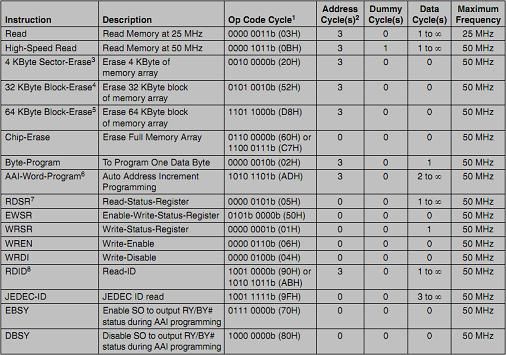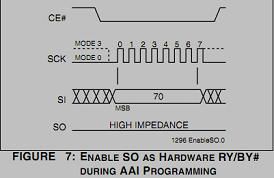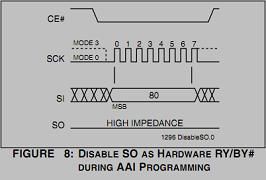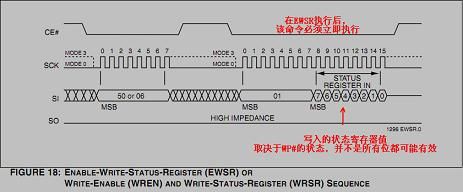FLASH 存储学习-串行SPI nor
分类: 嵌入式
关键点:容量、速度(时钟速度、读写速度)、功耗。
l 容量:8MBit;
l 最高SPI时钟频率:50MHz;
l 低功耗模式下电流消耗:5uA,正常读模式电流:15mA;低功耗!采用不同的制造技术功耗要低很多。
l 整片擦除:35ms;扇区/块擦除:18ms;字节编程:7us;整片擦除的速度要快很多!
1.2 系统框图与电路 1.2.1 系统框图关于内部存储矩阵的访问和存储结构同并行NorFlash的一致,只不过多了个串行接口,用于实现对串行数据的解码。
扇区大小4KB,块大小:32/64KB;页大小为字节或字。
1.2.3 引脚及封装引脚说明:
l SCK、SI、SO、CE – SPI接口控制线
l WP# -- 用于使能状态寄存器中的BPL位,有效时只允许锁定BPL,而不允许解锁BPL。不是说明使能保护!BPL位用于锁定控制扇区保护的相应位。
l HOLD# -- 用于暂停与SPI的通信,而不需要复位器件;
1.2.4 典型电路使用STM32F103驱动该器件时,典型的电路如图所示。
1.3 保护机制注意,WP为低,判定寄存器的锁定功能将启用。但不会太影响片内块的保护。
l 软件写保护:状态寄存器中的BP3—BP0、BPL提供片内块、状态寄存器的写保护。
l 硬件保护:WP#引脚—低电平,用于锁定状态寄存位7—BPL。由表2,WP#为高时,可以执行状态寄存器写命令,可随时更改状态寄存器。为低时,只能将BPL置为1,而不能从1置为0,即置1后,状态寄存器将锁定不变。
WP# àBPL、BP3—BP0
BPLàBP3、BP0
1.4 编程接口 1.4.1 状态寄存器状态寄存器用于用于获取FLASH的当前工作状态。
l BUSY位:指示是否正在编程或擦除操作;
l WEL位:指示器件是否处理可写的状态。RESET状态(0)指示不可写,默认在上电、完成写操作后,器件自行返回到不可写状态,以保护器件不受意外的擦写。因而每次写FLASH前,都必须先清除(写1),以使能器件的写。软件可控写。
l AAI位:指示器件是否处理地址自动增加模式或者是字节编程模式。
l BPL位:用于控制BPX是否可写。
l BPX位:用于控制保护块的范围,属于软件保护,扇区保护如下。
这里的扇区保护比较简单,更为复杂的扇区保护机制可针对每个扇区进行保护。
1.4.2 命令接口通信过程中,仅仅只有读ID、读数据、读状态寄存器需要在可保护CS不变而继续写数据。其它的则需要写完后接CS线。
1.5 通信时序 1. 单字 SPI 通信时序无论SPI总线空闲时SCK为高或为低,保证在上升沿采样数据,下降沿输出数据。先传送高位,每次传送8位。
2. 读命令 3. 快速读模式有可能内部使用了缓冲模式,可在更高的时钟速度(50MHz)下读数据。
4. 写使能该命令可设置状态寄存器中的WEL位,使得可执行擦除和编程命令。
即自动地址增量的字编程,每个周期写1个字。
在最后,通过WRDI返回来正常模式。在每写完两个字后,需查询害怕状态。
在写字的过程中,有三种方式检测是否完成字编程。其中硬件检测:读SO的状态。可在写AAI命令之前,通过命令配置SO口为RD/BY#状态。或者也可通过读取状态寄存器来检测是否完成写操作。
8. 4KB 的扇区擦除 9. 32K 块擦除 10. 64K 块擦除
两条命令必须连续写,不允许被打断?以避免意外写状态寄存器。
l 当WP#为低电平时,BPL只能写1,不可写0.;此时若BPL位为高时,写状态寄存器命令将被忽略。即此时,状态寄存器只能被锁定(写1),而不能再解锁(写0)!锁定后将不能再任意改高保护方式,相当于将当前的保护方式给固定下来!
l 而若WP#为高电平,BPL位失效,状态寄存器不再被锁定,此时BPL、BPX可被更改。BPL位可设置为1,也可设置为0。可任意更改保护方式。
WP#的作用,锁定BPL为1。一旦BPL锁定为1,则BPX将不可再更改,即软件保护将被锁定。当WP#无效时,BPL可随时、任意更改,同时更改软件保护。
14. JEDEC Read-ID获取SST制造商的ID和SST FLASH器件的ID。
驱动框架如下图:
算法编写原则:
(1) 可以为每一种SPI Flash针对性的写一份驱动源码,但是当更换Flash时,需要修改的地方很多;当系统中有多个设备时,显示这不够用,因而最好的方法是实现面向对像的封装,将与Flash设备相关的信息封装在一个结构体内,具体的算法根据结构体中相关的数据来决定如何访问硬件,做到过程可以不依赖于实际的硬件;
(2) 尽量按标准的初始化、读写、关闭、控制接口设计API,这样可统一抽像出相应的结构,也易于使用和理解。留给最终用户调用的API应该尽量的少和易于理解;
(3) SPI Flash接口为SPI,操作方法与并行接口一致,但其扇区组织类似,从最大到最小区域分为芯片-块-扇区-页。编程算法则也是通过写命令序列的方式,如发送命令字-发送字节-发送数据-查询状态寄存器。保护方式是通过存储器中的一些非易失性的位置0或置1选择性地以扇区或块为保护单位。
1.7 驱动代码点击(此处)折叠或打开
- // SST25VF080B驱动接口
- // By:lstzixing At ZLG
- // Date: 2011-1
- #include "STM32Lib\\stm32f10x.h"
- #include "hal.h"
-
- typedef unsigned long uint32;
- typedef unsigned short uint16;
- typedef unsigned char uint8;
-
- #define SPI_FLASH_SIZE (1024*1024*2) // SPI Flash容量
- #define SPI_FLASH_OK 0
- #define SPI_FLASH_ERR_PARA 3 // SPI Flash参数错误
-
- // SPI Flash擦除操作码
- #define SPI_FLASH_ERASE_CHIP 0 // 整片擦除
- #define SPI_FLASH_ERASE_SECTOR 1 // 扇区擦除
- #define SPI_FLASH_ERASE_BLOCK 2 // 块擦除
-
- // SPI状态寄存器和位
- #define SPI_FLASH_REG_BIT_BUSY (1 << 0)
- #define SPI_FLASH_REG_BIT_WEL (1 << 1)
- #define SPI_FLASH_REG_BIT_BPX (0xF << 2)
- #define SPI_FLASH_REG_BIT_AAI (1 << 6)
- #define SPI_FLASH_REG_BIT_BPL (1 << 7)
-
- #define SPIFlashSelect() GPIO_ResetBits(GPIOC, GPIO_Pin_13) /* SST CS = L */
- #define SPIFlashDeSelect() GPIO_SetBits(GPIOC, GPIO_Pin_13) /* SST CS = H */
-
- /*********************************************************************************************************
- ** Function name: SPIFlashInit
- ** Descriptions: 初始化SPI硬件,设置相关的GPIO口、SPI控制器
- ** Input parameters: none
- ** Output parameters: None
- ** Returned value: none
- *********************************************************************************************************/
- void SPIFlashInit(void)
- {
- // 打开SPI1和GPIO时钟
- RCC->APB2ENR |= RCC_APB2ENR_SPI1EN |
- RCC_APB2ENR_IOPAEN |
- RCC_APB2ENR_IOPBEN |
- RCC_APB2ENR_IOPCEN |
- RCC_APB2ENR_IOPDEN |
- RCC_APB2ENR_IOPEEN |
- RCC_APB2ENR_IOPFEN;
-
- // PA5/6/7为复用模式, 50MHZ
- GPIOA->CRL &= ~(GPIO_CRL_CNF5 | GPIO_CRL_CNF6 | GPIO_CRL_CNF7 |
- GPIO_CRL_MODE5 | GPIO_CRL_MODE6 | GPIO_CRL_MODE7);
- GPIOA->CRL |= GPIO_CRL_MODE5 | GPIO_CRL_MODE6 | GPIO_CRL_MODE7 |
- GPIO_CRL_CNF5_1 | GPIO_CRL_CNF6_1 | GPIO_CRL_CNF7_1;
-
- // 配置PC.13为输出片选线
- GPIOC->CRH &= ~(GPIO_CRH_CNF13 | GPIO_CRH_MODE13);
- GPIOC->CRH |= GPIO_CRH_MODE13;
-
- // 配置SPI1,第一个时钟沿采样、主机、分频最大、使能、软件从机管理
- SPI1->CR1 = //SPI_CR1_CPHA |
- SPI_CR1_MSTR |
- //SPI_CR1_BR |
- SPI_CR1_SSI |
- SPI_CR1_SPE |
- SPI_CR1_SSM;
-
- SPI1->CR2 = 0;
-
- SPIFlashDeSelect();
- }
-
- /*********************************************************************************************************
- ** Function name: SPIWriteReadByte
- ** Descriptions: 向SPI发送并读取一数据
- ** Input parameters: data 要发送的数据
- ** Output parameters: None
- ** Returned value: uint16 读取的数据
- *********************************************************************************************************/
- static uint16 SPIWriteReadByte(uint16 data)
- {
- // 发送一字节
- while((SPI1->SR & SPI_I2S_FLAG_TXE) == RESET);
- SPI1->DR = data;
-
- // 接收一字节
- while((SPI1->SR & SPI_I2S_FLAG_RXNE) == RESET);
- return(SPI1->DR);
- }
-
- /*********************************************************************************************************
- ** Function name: SPIFlashReadstatusReg
- ** Descriptions: 读状态寄存器
- ** Input parameters: none
- ** Output parameters: 当前状态寄存器的值
- ** BIT0 -- BUSY位,写忙标志
- ** BIT1 -- WEL位,FLASH处于写保护状态
- ** BIT6[5..2]--BP [3..0],扇区保护位
- ** BIT6 -- 指示正在自动自境编程中
- ** BIT7 -- BPL,BPX的保护位
- ** Returned value: none
- *********************************************************************************************************/
- static uint8 SPIFlashReadstatusReg (void)
- {
- uint8 uByte;
-
- // 发送读状态寄存器命令
- SPIFlashSelect();
- {
- SPIWriteReadByte(0x5);
- uByte = SPIWriteReadByte(0xFF);
- }
- SPIFlashDeSelect();
-
- return uByte;
- }
-
- /*********************************************************************************************************
- ** Function name: SPIFlashWritestatusReg
- ** Descriptions: 写状态寄存器
- ** Input parameters: status 要写入的值
- ** Output parameters: none
- ** Returned value: none
- *********************************************************************************************************/
- static void SPIFlashWritestatusReg (uint8 status)
- {
- // 发送使能状态寄存器写命令
- SPIFlashSelect();
- {
- SPIWriteReadByte(0x50);
- }
- SPIFlashDeSelect();
-
- // 写命令和状态值
- SPIFlashSelect();
- {
- SPIWriteReadByte(0x1);
- SPIWriteReadByte(status);
- }
- SPIFlashDeSelect();
- }
-
- /*********************************************************************************************************
- ** Function name: SPIFlashReadID
- ** Descriptions: 读SPI FLASH的JEDEC ID
- ** Input parameters: none
- ** Output parameters: 读的ID,从最高字节到最低字节:制造商ID(1B)-存储类型(1B)-存储容量(1B)
- ** Returned value: none
- *********************************************************************************************************/
- uint32 SPIFlashReadID (void)
- {
- uint32 spiID;
-
- // 发送低速读命令0x9F,3字节地址,写入的字节
- SPIFlashSelect();
- {
- SPIWriteReadByte(0x9F);
- spiID = SPIWriteReadByte(0xff) << 16;
- spiID |= SPIWriteReadByte(0xff) << 8;
- spiID |= SPIWriteReadByte(0xff);
- }
- SPIFlashDeSelect();
-
- return spiID;
- }
-
-
- /*********************************************************************************************************
- ** Function name: SPIFlashRead
- ** Descriptions: 以低速方式(<=25MHZ)从SPI FLASH读数据
- ** Input parameters: readBuf 读数据存储的缓冲区首址
- ** readCnt 要读取的数据量
- ** Output parameters: uint32 实际读得的数据量。当读地址超出芯片容量时,将只读在芯片地址范围内
- ** 的数据
- ** Returned value: none
- *********************************************************************************************************/
- uint32 SPIFlashRead (uint32 readAddr, uint8 * readBuf, uint32 readCnt)
- {
- uint32 i;
- uint8 addr[3];
-
- // 检查参数
- if (readAddr >= SPI_FLASH_SIZE ||
- readBuf == 0 ||
- readCnt == 0) {
- return SPI_FLASH_ERR_PARA;
- }
-
- // 校正要读的数据总量
- if (readAddr + readCnt >= SPI_FLASH_SIZE) {
- readCnt = SPI_FLASH_SIZE - readAddr;
- }
-
- // 将地址转换为字节数组
- addr[0] = (uint8)(readAddr >> 16);
- addr[1] = (uint8)(readAddr >> 8);
- addr[2] = (uint8)(readAddr & 0xff);
-
- // 等待SPI Flash完成写操作
- while (SPIFlashReadstatusReg() & SPI_FLASH_REG_BIT_BUSY );
-
- SPIFlashSelect();
- {
- // 发送低速读命令0x3,3字节地址
- SPIWriteReadByte(0x3);
- SPIWriteReadByte(addr[0]);
- SPIWriteReadByte(addr[1]);
- SPIWriteReadByte(addr[2]);
-
- // 依次读readCnt个数据
- for (i = 0; i < readCnt; i++) {
- readBuf[i] = SPIWriteReadByte(0xff);
- }
- }
- SPIFlashDeSelect();
-
- return i;
- }
-
- /*********************************************************************************************************
- ** Function name: SPIFlashFastRead
- ** Descriptions: 以高速方式(<=50MHZ)从SPI FLASH读数据
- ** Input parameters: readBuf 读数据存储的缓冲区首址
- ** readCnt 要读取的数据量
- ** Output parameters: uint32 实际读得的数据量。当读地址超出芯片容量时,将只读在芯片地址范围内
- ** 的数据
- ** Returned value: none
- *********************************************************************************************************/
- uint32 SPIFlashFastRead (uint32 readAddr, uint8 * readBuf, uint32 readCnt)
- {
- uint32 i;
- uint8 addr[3];
-
- // 检查参数
- if (readAddr >= SPI_FLASH_SIZE ||
- readBuf == 0 ||
- readCnt == 0) {
- return SPI_FLASH_ERR_PARA;
- }
-
- // 校正要读的数据总量
- if (readAddr + readCnt >= SPI_FLASH_SIZE) {
- readCnt = SPI_FLASH_SIZE - readAddr;
- }
-
- // 将地址转换为字节数组
- addr[0] = (uint8)(readAddr >> 16);
- addr[1] = (uint8)(readAddr >> 8);
- addr[2] = (uint8)(readAddr & 0xff);
-
- // 等待SPI Flash完成写操作
- while (SPIFlashReadstatusReg() & SPI_FLASH_REG_BIT_BUSY );
-
- SPIFlashSelect();
- {
- // 发送低速读命令0x3,3字节地址,dummy字节
- SPIWriteReadByte(0xB);
- SPIWriteReadByte(addr[0]);
- SPIWriteReadByte(addr[1]);
- SPIWriteReadByte(addr[2]);
- SPIWriteReadByte(0xff);
-
- // 依次读readCnt个数据
- for (i = 0; i < readCnt; i++) {
- readBuf[i] = SPIWriteReadByte(0xff);
- }
- }
- SPIFlashDeSelect();
-
- return i;
- }
-
- /*********************************************************************************************************
- ** Function name: SPIFlashWriteByte
- ** Descriptions: 向SPI Flash指定地址处写一字节数据
- ** Input parameters: writeAddr 写入的地址
- ** udata 写入的值
- ** Output parameters: none
- ** Returned value: none
- ** Notes: 写之前必须注意到写保护的存储影响
- *********************************************************************************************************/
- uint32 SPIFlashWriteByte (uint32 writeAddr, uint8 uByte)
- {
- uint8 addr[3];
-
- // 检查写地址是否越界
- if (writeAddr >= SPI_FLASH_SIZE) {
- return SPI_FLASH_ERR_PARA;
- }
-
- // 将地址转换为字节数组
- addr[0] = (uint8)(writeAddr >> 16);
- addr[1] = (uint8)(writeAddr >> 8);
- addr[2] = (uint8)(writeAddr & 0xff);
-
- // 等待SPI Flash完成写操作
- while (SPIFlashReadstatusReg() & SPI_FLASH_REG_BIT_BUSY );
-
- // 发送写使能命令
- SPIFlashSelect();
- {
- SPIWriteReadByte(0x06);
- }
- SPIFlashDeSelect();
-
- // 写入实际要写入的数据
- SPIFlashSelect();
- {
- // 发送低速读命令0x3,3字节地址,写入的字节
- SPIWriteReadByte(0x2);
- SPIWriteReadByte(addr[0]);
- SPIWriteReadByte(addr[1]);
- SPIWriteReadByte(addr[2]);
- SPIWriteReadByte(uByte);
- }
- SPIFlashDeSelect();
-
- return SPI_FLASH_OK;
- }
-
- /*********************************************************************************************************
- ** Function name: SPIFlashFastWrite
- ** Descriptions: 以地址自增方式向指定FLASH地址处连续写字数据
- ** Input parameters: writeAddr 写入的起始地址
- ** writeBuferr 写数据存储的缓冲区
- ** uWord 写入的数据量,以字为单位
- ** Output parameters: none
- ** Returned value: none
- ** Notes: 写之前必须注意到写保护的存储影响
- *********************************************************************************************************/
- uint32 SPIFlashFastWrite (uint32 writeAddr, uint16 * writeBuferr, uint16 uWord)
- {
- uint16 i;
- uint8 addr[3];
-
- // 检查参数
- if (writeAddr >= SPI_FLASH_SIZE ||
- writeBuferr == 0 ||
- uWord == 0) {
- return SPI_FLASH_ERR_PARA;
- }
-
- // 检查写地址是否越界
- if (writeAddr + (uWord << 1) >= SPI_FLASH_SIZE) {
- uWord = (SPI_FLASH_SIZE - writeAddr) >> 1;
- }
-
- // 将地址转换为字节数组
- addr[0] = (uint8)(writeAddr >> 16);
- addr[1] = (uint8)(writeAddr >> 8);
- addr[2] = (uint8)(writeAddr & 0xff);
-
- // 等待SPI Flash完成写操作
- while (SPIFlashReadstatusReg() & SPI_FLASH_REG_BIT_BUSY );
-
- // 发送写使能命令
- SPIFlashSelect();
- {
- SPIWriteReadByte(0x06);
- }
- SPIFlashDeSelect();
-
- // 发送低速读命令0xAD,3字节地址,写入的字节
- SPIFlashSelect();
- {
- SPIWriteReadByte(0xAD);
- SPIWriteReadByte(addr[0]);
- SPIWriteReadByte(addr[1]);
- SPIWriteReadByte(addr[2]);
- SPIWriteReadByte(writeBuferr[0] >> 0x08);
- SPIWriteReadByte(writeBuferr[0] & 0xFF);
- }
- SPIFlashDeSelect();
-
- // 发送其它字节
- for (i = 1; i < uWord; i++) {
- // 等待SPI Flash完成写操作
- while (SPIFlashReadstatusReg() & SPI_FLASH_REG_BIT_BUSY );
-
- SPIFlashSelect();
- {
- // 发送引导命令和编程字数据
- SPIWriteReadByte(0xAD);
- SPIWriteReadByte(writeBuferr[i] >> 0x08);
- SPIWriteReadByte(writeBuferr[i] & 0xFF);
- }
- SPIFlashDeSelect();
- }
-
- // 等待SPI Flash完成写操作
- while (SPIFlashReadstatusReg() & SPI_FLASH_REG_BIT_BUSY );
-
- // 发送写禁能命令,退出该模式
- SPIFlashSelect();
- {
- SPIWriteReadByte(0x04);
- }
- SPIFlashDeSelect();
-
- return SPI_FLASH_OK;
- }
-
-
- /*********************************************************************************************************
- ** Function name: SPIFlashChipErase
- ** Descriptions: 擦除整块芯片
- ** Input parameters: none
- ** Output parameters: none
- ** Returned value: none
- ** Note: 如果sectorAaddr
- *********************************************************************************************************/
- void SPIFlashErase (uint8 eraseType, uint32 eraseAddr)
- {
- uint8 addr[3];
-
- // 等待SPI Flash完成写操作
- while (SPIFlashReadstatusReg() & SPI_FLASH_REG_BIT_BUSY );
-
- // 发送写使能命令
- SPIFlashSelect();
- {
- SPIWriteReadByte(0x06);
- }
- SPIFlashDeSelect();
-
- // 根据类型选择擦除方式
- switch (eraseType) {
- // 选择整片擦除方式
- case SPI_FLASH_ERASE_CHIP:
- SPIFlashSelect();
- {
- SPIWriteReadByte(0x60);
- }
- SPIFlashDeSelect();
- break;
-
- // 扇区擦除方式
- case SPI_FLASH_ERASE_SECTOR:
- if (eraseAddr < SPI_FLASH_SIZE) {
- // 将地址转换为字节数组
- addr[0] = (uint8)(eraseAddr >> 16);
- addr[1] = (uint8)(eraseAddr >> 8);
- addr[2] = (uint8)(eraseAddr & 0xff);
-
- // 发送扇区擦除命令,擦除的扇区地址
- SPIFlashSelect();
- {
- SPIWriteReadByte(0x20);
- SPIWriteReadByte(addr[0]);
- SPIWriteReadByte(addr[1]);
- SPIWriteReadByte(addr[2]);
- }
- SPIFlashDeSelect();
- }
- break;
-
- // 32K块擦除方式
- case SPI_FLASH_ERASE_BLOCK:
- if (eraseAddr < SPI_FLASH_SIZE) {
- // 将地址转换为字节数组
- addr[0] = (uint8)(eraseAddr >> 16);
- addr[1] = (uint8)(eraseAddr >> 8);
- addr[2] = (uint8)(eraseAddr & 0xff);
-
- // 发送块擦除命令,擦除的块地址
- SPIFlashSelect();
- {
- SPIWriteReadByte(0x52);
- SPIWriteReadByte(addr[0]);
- SPIWriteReadByte(addr[1]);
- SPIWriteReadByte(addr[2]);
- }
- SPIFlashDeSelect();
- }
- break;
-
- default:
- break;
- }
-
-
- }
-
- /*********************************************************************************************************
- ** Function name: SPIFlashSetProtection
- ** Descriptions: 设定SPI存储器的保护模式,加保护或解保护
- ** Input parameters: isProtect 保护的模式,1--加保护, 0 -- 解保护
- ** startAddr 保护区域的起始地址
- ** stopAddr 保护区域的结束地址
- ** Output parameters: 0 -- 操作成功, 1 -- 操作失败(当为解保护时,硬件保护阻止了解保护)
- ** Returned value: none
- *********************************************************************************************************/
- uint32 SPIFlashSetProtection (uint8 isProtect, uint32 startAddr, uint32 stopAddr)
- {
- uint8 BPXMask;
- uint8 status;
-
- // 等待SPI Flash完成写操作
- while (SPIFlashReadstatusReg() & SPI_FLASH_REG_BIT_BUSY );
-
- if (isProtect) {
- // 清除所有的保护位
- SPIFlashWritestatusReg(0);
-
- // 如果BPL只读,即不可更改BPX位
- if (SPIFlashReadstatusReg() & SPI_FLASH_REG_BIT_BPL) {
-
- // 当该区域已经加保护时,正确返回
- if ((status & SPI_FLASH_REG_BIT_BPX) > BPXMask) {
- return 0;
- } else {
- // 当未加保护时,返回错误,不可更改保护模式
- return 1;
- }
-
- } else {
- // 计算保护模式位
- if (startAddr > SPI_FLASH_SIZE) {
- return 0;
- } else if (startAddr >= 0xF0000) {
- BPXMask = 0x1 << 2;
- } else if (startAddr >= 0xE0000) {
- BPXMask = 0x2 << 2;
- } else if (startAddr >= 0xC0000) {
- BPXMask = 0x3 << 2;
- } else if (startAddr >= 0x80000) {
- BPXMask = 0x4 << 2;
- } else {
- BPXMask = 0x5 << 2;
- }
-
- // BPL写读写,此时加上保护位即可,但不锁定BPL,以妨不可恢复
- SPIFlashWritestatusReg(BPXMask);
-
- return 0;
- }
- } else {
- // 解除保护,写BPL位为0,解除保护
- SPIFlashWritestatusReg(0);
-
- // 读保护位,如果值不为全0,则可能硬件加保护,解保护失败
- if (SPIFlashReadstatusReg() & SPI_FLASH_REG_BIT_BPX) {
- return 1;
- } else {
- return 0;
- }
- }
- }
-
-
- /* -------------------------------------------------- 测试代码 ---------------------------------------*/
- uint32 id;
- uint8 writeBuffer[1024];
- uint8 readBuffer[1024];
- uint8 status;
-
- #define SPI_FLASH_SECTOR_SIZE (1024*4)
- #define SPI_FLASH_BLOCK_SIZE (1024*32)
-
- void SPIFlashTest (void)
- {
- uint32 i, j;
-
- // 初始化SPI控制器
- SPIFlashInit();
-
- // 读ID测试,值应为0x00BF258E
- id = SPIFlashReadID();
- if (id != 0x00BF258E) {
- return;
- }
-
- // 先解除保护才可写
- SPIFlashSetProtection(0, 0xF0000, 0xFFFFF);
-
- // 整片擦除测试
- SPIFlashErase(SPI_FLASH_ERASE_CHIP, 0);
- for (i = 0; i < SPI_FLASH_SIZE / sizeof(readBuffer); i++) {
- SPIFlashRead(i * sizeof(readBuffer), readBuffer, sizeof(readBuffer));
- for (j = 0; j < sizeof(readBuffer); j++) {
- if (readBuffer[j] != 0xff) {
- return;
- }
- }
- }
-
- // 字节写和读测试
- for (i = 0; i < SPI_FLASH_SIZE; i++) {
- SPIFlashWriteByte(i, i);
- SPIFlashRead (i, readBuffer, 1);
- if( readBuffer[0] != (i & 0xff)) {
- return;
- }
- }
-
- // 扇区擦除测试
- for (i = 0; i < SPI_FLASH_SIZE / (4*1024); i++) {
- SPIFlashErase(SPI_FLASH_ERASE_SECTOR, i * (4*1024));
- }
- for (i = 0; i < SPI_FLASH_SIZE / sizeof(readBuffer); i++) {
- SPIFlashRead(i * sizeof(readBuffer), readBuffer, sizeof(readBuffer));
- for (j = 0; j < sizeof(readBuffer); j++) {
- if (readBuffer[j] != 0xff) {
- return;
- }
- }
- }
-
- // 快速写测试
- for (i = 0; i < SPI_FLASH_SIZE / sizeof(writeBuffer); i++) {
- for (j = 0; j < sizeof(writeBuffer); j++) {
- writeBuffer[j] = j;
- }
- SPIFlashFastWrite( i * sizeof(writeBuffer), (uint16 *)writeBuffer, sizeof(writeBuffer) >> 1);
- SPIFlashFastRead ( i * sizeof(writeBuffer), (uint8 *)readBuffer, sizeof(readBuffer));
-
- // 交换字节顺序再比较
- for (j = 0; j < sizeof(writeBuffer) >> 1; j++) {
- uint16 * ptr = (uint16 *)&readBuffer[j << 1];
- *ptr = ((*ptr & 0xff) << 8) | (*ptr >> 8);
- }
- if( memcmp( writeBuffer, readBuffer, sizeof(readBuffer)) != 0) {
- return;
- }
- }
-
- // 扇区擦除测试
- for (i = 0; i < SPI_FLASH_SIZE / (32*1024); i++) {
- SPIFlashErase(SPI_FLASH_ERASE_BLOCK, i * (32*1024));
- }
- for (i = 0; i < SPI_FLASH_SIZE / sizeof(readBuffer); i++) {
- SPIFlashRead(i * sizeof(readBuffer), readBuffer, sizeof(readBuffer));
- for (j = 0; j < sizeof(readBuffer); j++) {
- if (readBuffer[j] != 0xff) {
- return;
- }
- }
- }
-
- // 保护测试
- SPIFlashSetProtection(1, 0xF0000, 0xFFFFF);
- SPIFlashSetProtection(1, 0x80000, 0xFFFFF);
- SPIFlashSetProtection(0, 0xF0000, 0xFFFFF);
- }


















